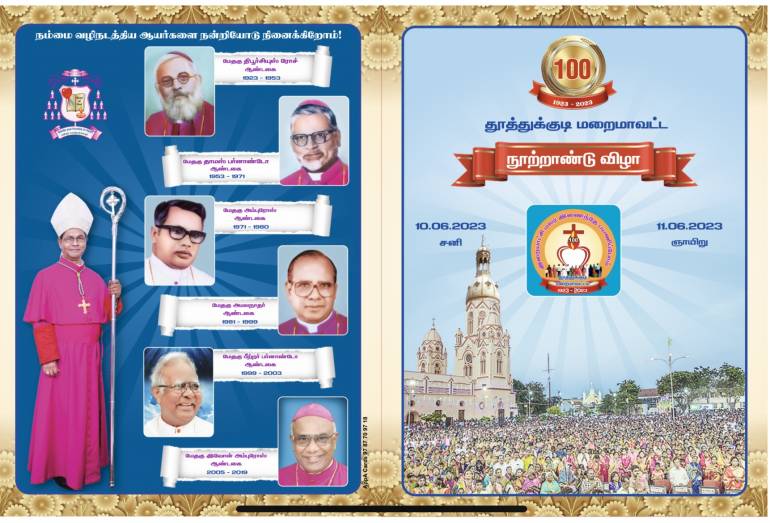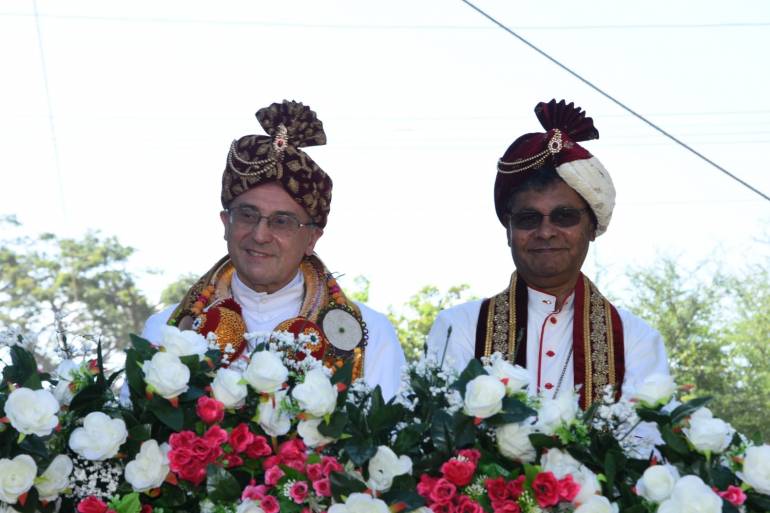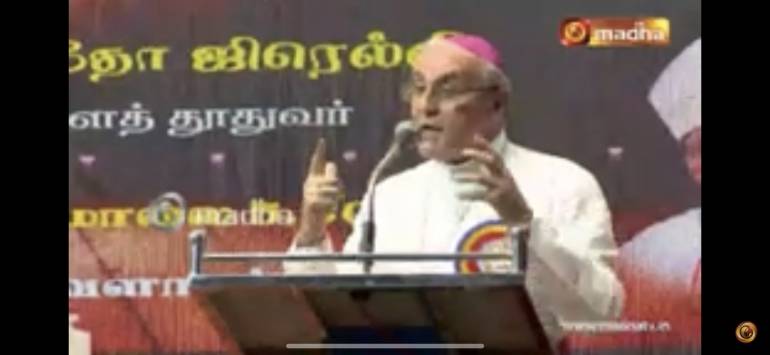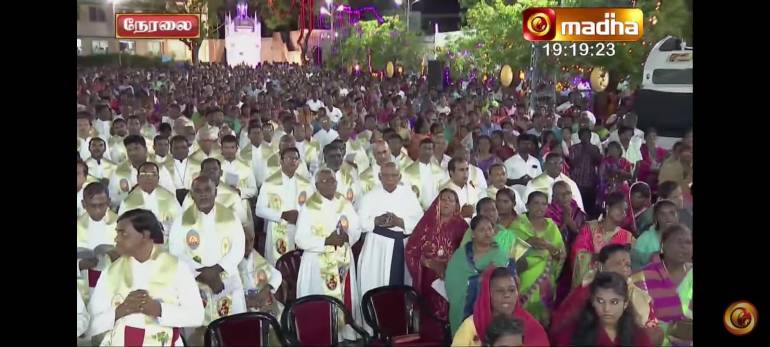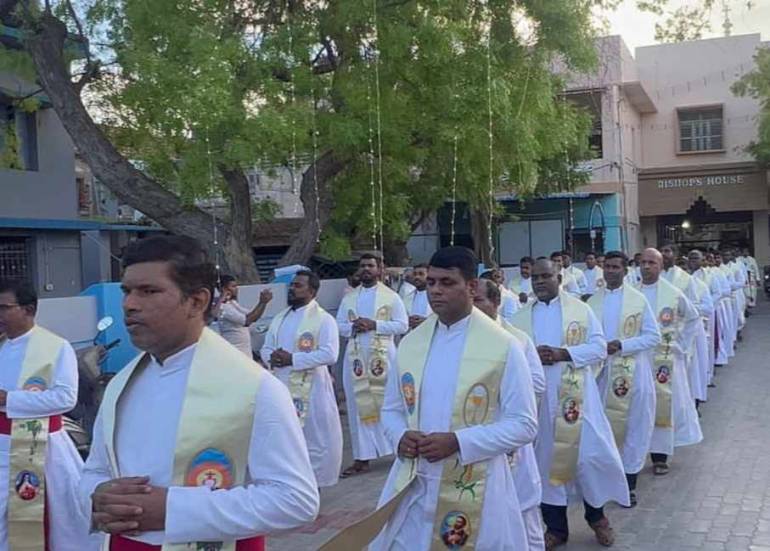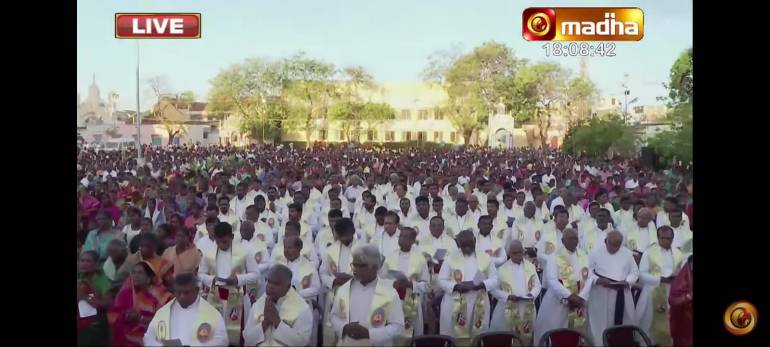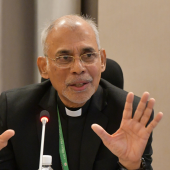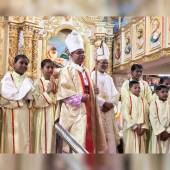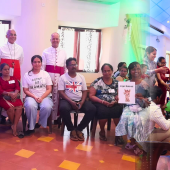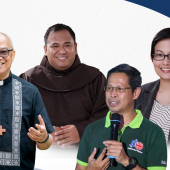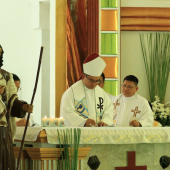India: Tuticorin diocese marks its centenary celebration
A southern Indian Catholic diocese marked its centenary celebration on June 10-11.
The Diocese of Tuticorin is situated in the southeast of Tamil Nadu State, in south India.
Archbishop Leopoldo Girelli, Apostolic Nuncio to India and Nepal, was one of the chief guests on the occasion, along with other church leaders from the Tamil Nadu region, India, and other government officials.
Cardinal Oswald Gracias, Archbishop of Bombay, and Cardinal Anthony Poola, Archbishop of Hyderabad, were other guests.
The diocese of Tuticorin comprises the major part of the Tuticorin district, nearly half of the Nellai district, and a small portion of the Kanyakumari district.
The Catholics of this area trace their origins to the time of Jesuit St. Francis Xavier, who spent most of his missionary life there.
Bifurcated from the diocese of Tiruchirapalli, Tuticorin was erected as a new diocese and entrusted to the diocesan clergy on June 12, 1923, by Pope Pius XI.
Jesuit Bishop Francis Tiburtius Roche was consecrated as the first bishop of the Diocese of Tuticorin on September 23, 1923. He was also the first Indian bishop of the Latin Rite.
The new diocese had 18 parishes and 23 diocesan priests at that time. The diocese covers 6440 square miles.
St. Francis Xavier and St. Teresa of the Child Jesus are the patrons of the diocese.
The past bishops who worked tirelessly for the diocese include Francis Tiburtius Roche, S.J, Thomas Fernando, Ambrose Mathalaimuthu, Siluvaimathu Teresanathan Amalnather, Peter Fernando, and Yvon Ambroise.
The present bishop is Stephen Antony Pillai from 2019:
Today, there are 119 parishes, more than 300 sub-stations, 5 Vicariates, and about 5,00,000 Catholics in this diocese.
Tuticorin is the biggest diocese in Tamil Nādu and the third biggest diocese in India.
As many as 247 diocesan priests, about 60 religious priests, around 40 religious brothers, and more than 770 nuns are doing their ministry in and for the diocese.
As many as 137 priests who worked earlier have died after rendering their selfless service to the diocese for years.
Many catechists who were formed have done significant work in the diocese. Currently, the diocese has seven catechists.
"When we start to compute the number of priests and religious, born and brought up in the diocese but working outside of the diocese and India will go more than a thousand," said Bishop Stephen.
Altogether, seven novice houses, minor seminaries, and five retreat centers are in the diocese.
The Contribution of the Religious:
Even before the institution of the diocese, focus was given to education. In 1905 St. Aloysius primary school for girls began to function. It blossomed into a girls' high school in 1925.
In 1942, the Holy Cross Sisters established an Anglo-Indian School in Tuticorin, which proudly shines well.
Tuticorin diocese has benefitted from the excellent services of Jesuits, Capuchins, OCDs, Rosarians, Salesians Fathers, De La Salle, and Sacred Heart brothers. According to the bishop, their yeomen service has seen incredible development in the diocese.
The diocese cannot forget the untiring service of the Servites, Bon Secours, and Franciscan Missionary Sisters of Mary in the field of education, hospital, and other charitable activities.
FMM Sisters worked among the lepers. Thanks to them, leprosy is, to a certain extent, eradicated. St. Mary’s College, run by the Servites, has done miracles for the development of young girls.
Sisters of St. Ann's of Luzern run the Sacred Heart Hospital and Schools, and the Little Sisters of the Poor accommodate more than 100 elderly people, shelter them and care for them. Their sacrificial service gives relief to thousands of people.
Education:
"We have been the pioneers in bequeathing the educational institutions," said Bishop Stephen.
St. Teresa’s school at Vadakkangulam, St. Joseph’s school at Manapad, and the Holy Redeemer’s school at Thisayanvilai were common schools.
Now, it has seven kindergartens, 134 primary schools, 60 middle schools, 20 high schools, 30 higher secondary schools, 20 English medium schools, one teacher training institute, ten industrial training institutes, 1 B.Ed. College and five arts and science colleges in the diocese (run by the diocese and the religious).
"We have also started a training center at ‘Mukthiyudaiyan Naduvam’ for those who aspire to become government officers," said the bishop.
Furthermore, at Kuthenkuly, the diocese has already laid the foundation for opening a Maritime Academy for youngsters, especially those who aspire to excel in the marine field.
"We have also laid the foundation for a de-addiction center. Soon the South Zone would see its Pastoral Centre. With the cooperation of the people, it would enjoy a bright future," said Bishop Stephen.
Social Activities:
A monumental and historical institute known as St. Joseph’s Charity Institute was founded in 1854 in Alanthalai, then three years later, it was shifted to Adaikalapuram. It has been the diocese's crown and heart for more than 170 years. It serves the poor of all kinds. The diocese has incessantly expanded its service to the poor and society.
The diocese runs several social and charitable institutions along with the religious.
Involvement of the Laity:
Lay movements have also helped to play much of the role of the laity in the Diocese. The Legion of Mary, Vincent de Paul, Amalorpavamatha Sabai, De-Addiction Society, and other modalities have helped the lay people engage actively in the diocese mission. Laity Centre, Good News Centre, and Kallamozhi Fishermen Welfare Centre gave new impetus to the laity. The Diocese took special care of low-income people by starting an education center.
Pioneers:
Interestingly note that in 1938 Little Flower Seminary began to function at Vadakkankulam.
In 1946, it was shifted to Innaciarpuram, Tuticorin. In 1970, the Diocese established the Pastoral Centre, the first in Tamil Nadu, and had a recording station.
In 1978 Father Antony founded St. Lucia Institute for the Blind and other disabled children. It renders charitable service to people with low incomes. A lot of benefactors help them.
This Pastoral Centre produced daily reading books (Lectionary), Responsorial Psalm books, books on vespers, and prayer books for funeral services.
Father Lawrence Xavier Fdo from Manapad was the first indigenous priest of India (1894), and Bishop Tiburtius Roche was the first indigenous Bishop of India.
The Diocese of Tuticorin Introduces the first VBS for young students during their summer holidays. It spread like wildfire in the region of Tamil Nadu.
Astonishingly, it had its own Communication Centre known as Pavalam TV. There has been a special sodality for de-addiction in the Diocese.
The Diocese is proud of its first Catholic member of the Legislative Assembly, Mrs. Jeya Mani Masila Mani.
It is to be recorded that Mr. Yahappa Pillai (Vadakkankulam), Mrs. Pitchaikariammal Fdo (Manapad), Mr. Viyagulam Miranda (Manapad), Mr. Antony Michael Fdo (Idinthakarai), Mr.Thambiaya Pillai (Vembar) received Benemerendi awards from the Pope. Again Mr. I.X. Perira, Mr. Christian Gomez, Mr. J. L. P. Roche, C.I.R. Machado, and Mr. T.R. Pinnheira were awarded Chevalier distinction.
Blessed Antony Susainathar and Augustine Pereira, Peter Paradesi, Fr. Adrian Causannel, St. Devasagayam, St. John De Britto, and Veeramamunivar are connected to the Diocese of Tuticorin.
Blood of the Martyrs:
The Pearl City people became Christians in the middle of the 16th century, and it had a history filled with heroic deeds and untold sufferings they endured to uphold their devotion to Jesus.
The enemies inflicted on them unimaginable destruction and devastation. As a result, they sought the help of the Portuguese and got baptized as Christians.
In this period came the great missionary St. Francis Xavier, who strengthened their faith. He converted many to Christianity in his time in the coastal villages from Kanyakumari to Rameshwaram.
Credit goes to Father Henricks, who gave identity to them. He formed parishes. At Punnaikayal, he started the first college, the first dispensary, the first printing press, and the first one to print in Tamil the prayers and started a seminary.
Being trained by strong missionaries, the Christians manifested their faith in times of aggression and oppression by their enemies.
At age 20, Father Antony Criminali came to Tamil Nadu and learned Tamil. He visited all the coastal villages from Kanyakumari to Rameshwaram. At this time, war broke out. The king of Vijayanagar attacked Christians and killed some of them. These people shed their blood for their faith.
Father Criminali was to be killed by a spear, but Louis Alphonse bore it in his body and died and became a real martyr indeed. Father Criminali was later beheaded and died an ignominious death of a martyr.
Another incident is of five Catholics being beheaded and dying for their faith. The Diocese has grown on the blood of the martyrs.
In 1641- 43, two women died safeguarding their virginity when attacked by vicious soldiers.
There had been occasions when the Christians were burnt alive; Bro. Mendis was also killed because he gave protection to the Christians. This happened in Kanyakumari. Christianity is still active and dynamic because their forefathers gave witness to their Master Jesus through their heroic lives and became martyrs.
"Let the blood of the martyrs be a sign of God's presence and power, which enlivens the lives of the Christians, especially the faithful of our diocese," said Bishop Stephen. – Santosh Digal
Radio Veritas Asia (RVA), a media platform of the Catholic Church, aims to share Christ. RVA started in 1969 as a continental Catholic radio station to serve Asian countries in their respective local language, thus earning the tag “the Voice of Asian Christianity.” Responding to the emerging context, RVA embraced media platforms to connect with the global Asian audience via its 21 language websites and various social media platforms.





